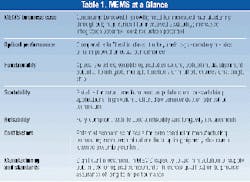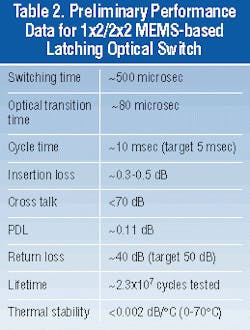MEMS components will play a vital role in optical-network evolution
In key metrics, micro-electromechanical systems technology offers best-in-class performance.
Dave Danagher, Ken Garrett, and Jesko von Windheim
JDS Uniphase
Rapid deployment of optical systems in long-haul and metropolitan networks has created new requirements for optical components.
Future networks must allow faster installation and reconfiguration of bandwidth at the optical layer through control of optical power levels and real-time management of optical connections. Bandwidth demand is already exceeding Moore's Law, established over several decades in the semiconductor industry, which states that processor density will double every 18 months. By deploying remotely configurable optics, service providers will be able to offer end users faster access to more bandwidth and reduce operating costs through the use of distributed protection at the optical layer.
New optical technologies are needed, however. These technologies must offer high performance, integrate functionality, scale, and be delivered quickly in high volumes at lower cost.One component technology generating significant attention is micro-electromechanical systems (MEMS), which are mechanical structures fabricated in silicon, metal, or glass using semiconductor-compatible manufacturing techniques. These devices offer excellent optical performance-low insertion loss, wavelength flatness, minimal crosstalk-and hold promise for improved integration, scalability, and reliability. Since the technology is based on manufacturing methods and processes proven over many years in the semiconductor industry, it is reasonable to expect steady cost reduction with increasing volumes.
The role that MEMS are currently playing in optical networking-specifically the technology's potential for increasing scalability and manageability of optical networks-is a response to the operators' need for maximum performance and flexibility at a lower cost of ownership.
Technologies like DWDM allow service providers to increase the number of channels through a fiber by increasing the number of wavelengths within each fiber. Companies have introduced DWDM systems for metro networks that provide low-cost bandwidth and support various protocols, including SONET, Gigabit Ethernet, digital video, and Escon. These systems have the capability to transparently add or drop a specific optical channel and intelligently manage wavelengths to maximize network efficiency.
DWDM systems require components that meet a stringent set of optical performance standards. Components are evaluated for network applications based on insertion loss, polarization-dependent loss (PDL), and wavelength flatness of 1,310 nm and 1,550 nm in the C- and L-bands. Channel integrity must be maintained over long distances; as such, any new component must not impart phase or intensity noise onto the channels, and very low crosstalk between channels must be maintained. Size and power dissipation must be minimized to conserve user floor space and operating costs.
Many component technologies have been introduced for switching and attenuator applications in the optical network, including optomechanical, waveguide, liquid-crystal, and MEMS-based technology. Each of these technologies has certain properties that will be used in the network to optimize performance, depending on the application.
MEMS-based devices are intriguing because they can be designed to operate with low loss over any wavelength band-critical for DWDM operation. A full assessment requires that MEMS components be evaluated in five key areas: performance, functionality, scalability, reliability, and cost (see Table 1).
Performance. Designers of optical systems and networks consider performance the most basic and essential factor when evaluating components. A higher-performance component is often chosen over a lower-cost alternative, because the total system cost is reduced (i.e., more capacity and longer distances can be achieved for a lower overall system cost). For example, a lower-loss but higher-cost optical component may be selected to reduce the erbium-doped fiber amplifier (EDFA) noise in a repeater, which will lower overall system cost due to the longer repeater spacing.
MEMS components offer performance advantages over alternative technologies, with the added benefits of smaller size and greater suitability for volume manufacturing. In the key performance metrics-insertion loss, wavelength flatness, PDL, and crosstalk-MEMS offer best-in-class performance compared to alternative technologies. For example, a MEMS-based 2x2 optical-switch module has been shown to achieve an insertion loss of 0.4 dB, a PDL of <0.07 dB, and crosstalk of <-70 dB. Table 2 lists preliminary performance data for a 1x2/2x2 MEMS-based latching optical switch.
MEMS-based devices have small footprints and can be designed to operate with minimal power dissipation. These systems also offer scalability through the integration of optics and the actuator on a single chip or by arraying multiple devices together.
Functionality and scalability. Given the excellent optical performance capability of MEMS-based devices, the technology fits well with the existing and evolving requirements of optical networks. The 1x2 and 2x2 MEMS-based switches will allow small-form-factor optical protection, no matter what the bit rate or protocol. The 1xN MEMS topology will help lower the size and cost of network monitoring equipment by sharing a relatively expensive monitor over several fibers or channels at a network node. Scalable MEMS mirror chips (2-D and 3-D designs) will enable medium and large optical nodes that can reconfigure traffic at wavelength granularity and therefore allow lower-cost mesh architectures to be deployed. The 2-D technology based on two position-state mirrors can be scaled using Clos architecture up to several hundred nonblocking connections before insertion losses limit further scalability. Single-stage 3-D tilting mirror designs are being considered for large node applications with thousands of ports.A critical application in optical networks is remote power control. MEMS can deliver wavelength- and polarization-independent attenuation by controlled insertion of a vane into the light path or by tilting a mirror to control the level of power reflected back into the signal path. MEMS chips may also be used in lowering the cost associated with coupling the optical chip to the fiber. Fiber alignment or device alignment can be implemented on-chip by fabrication of movable V-grooves and platforms in a silicon micro-optical bench. MEMS provide the ability to integrate multiple levels of functionality on a single chip, thus offering a path toward chip-level systems.
Reliability. The reliability of MEMS devices has in part already been demonstrated in other applications. For example, the technology has been used in automobile air-bag applications for several years. Flexure-based mechanical motion will ensure a long lifetime for MEMS-based devices. In addition, extensive reliability testing is used to prove-in the MEMS design, including temperature cycling, shock, vibration, and long-term high-temperature storage testing according to standards established by Telcordia Technologies (formerly Bellcore).
Cost. MEMS devices offer several opportunities for reducing system cost. The functionality of MEMS chips allows lower-cost network setup and configuration as well as protection at the optical layer. The small size and power requirements of MEMS results in smaller system footprints, freeing up expensive real estate in repeater and terminal nodes. MEMS-based components also offer the advantage of higher yields, improved device-to-device reproducibility, and the economies of scale associated with producing a large number of devices at a single time. Integration of the actuator with the optics on a single chip is repeated many times on a silicon wafer, leading to lower-cost subcomponents. These savings can ultimately be passed on to system suppliers through reduced prices of components.
Optical components positioned to exploit MEMS as a base technology include variable optical attenuators (VOAs), optical switches, and optical crossconnects. VOAs are used within optical systems to provide network and system power management. These devices serve as a key component in optical amplifier implementations to ensure that optical power levels are maintained throughout the network. Similar to industry-standard optomechanical components, MEMS-based attenuators offer the capability to support applications with low insertion loss, wide attenuation range, and Telcordia-qualified reliability.
Optical switching is another component area where MEMS is taking proven approaches and offering a new design. Optomechanical components have made major inroads into the optical-switching market using custom packaging techniques to allow switching devices to operate over a wide temperature range. MEMS devices are poised to do the same, offering some advantages in printed-circuit-board real estate because of their small form factors.
Recently, MEMS have been introduced that switch several hundred to more than 1,000 optical transmissions within a single device. MEMS optical-crossconnect component modules are available in 4x4 to 32x32 configurations. These devices can be a part of a larger switching fabric to address requirements up to 256x256. Due to an all-optical architecture, these crossconnect modules offer unlimited bandwidth, wavelength transparency, and route diversity, all requirements for next-generation networks.
After demonstrating MEMS's capabilities in enhancing optical networks, the MEMS industry is focusing on developing the manufacturing infrastructure to achieve widespread component distribution. Major investment to expand MEMS chip manufacturing and packaging capacity is taking place. MEMS-based products represent a new generation of optical components designed for high-volume manufacturing.
A critical step toward mass deployment of MEMS devices is meeting industry standards. Within the telecommunications industry, Telcordia specifications remain the de facto standards for performance and reliability.
Manufacturers and system operators readily accept standards specific to optical communications, such as GR-1209 for fiber-optic branching components and GR-1221 for passive optical components, as benchmark criteria. These rigorous standards, however, are not always written with new technology in mind. The industry is working with customers to develop MEMS-specific test procedures based on Telcordia objectives. For example, elevated temperature is used as an aging technique to simulate end-of-life performance for standard semiconductors. But with MEMS devices, the time degradation phenomena are different from those of standard semiconductor devices. To counter that, a methodology of deriving activation energy for thermally driven MEMS devices has been developed to allow an Ahrenius Law prediction of device-specific aging stresses. In this way, equivalent end-of-life testing can be conducted with the same assurance of device reliability as the accepted procedures for semiconductor equipment.
On a similar note, the telecommunications industry is embracing the TL9000 standard, a variation of ISO 9000 developed specifically for telecom products. Suppliers of MEMS devices for the telecom industry are being certified for TL9000 to assure customers that appropriate quality standards are in place.
Clearly, MEMS-based devices meet the performance requirements of today's optical networks. This technology also supports the scalability, small size, and low power dissipation required for components in next-generation systems. Providers of optical-networking equipment can fully utilize these advantages with the arrival of MEMS-based optical components in the near future.
Dave Danagher is business unit director of optical switches, switching modules, and attenuators, and Ken Garrett is business development director of optical switching at JDS Uniphase in Ottawa, Ontario. Jesko von Windheim is vice president of marketing and business development at Cronos Integrated Microsystems (Research Triangle Park, NC), a unit of JDS Uniphase.


